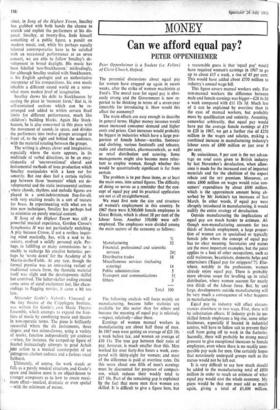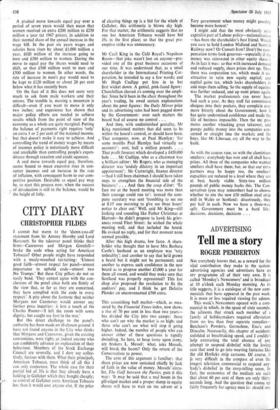Can we afford equal pay? MONEY
PETER OPPENHEIMER
Peter Oppenheimer is a Student (i.e. Fellow) of Christ Church, Oxford.
The perennial discussions about equal pay for women have cropped up again in recent weeks, after the strike of women machinists at Ford's. The moral case for equal pay is obvi- ously strong and the Government is now re- ported to be thinking in terms of a seven-year timetable for introducing it. How would this affect the economy?
The main effects are easy enough to describe in general terms. Higher money incomes would mean increased consumer demand and higher costs and prices. Cost increases would probably be biggest in industries which have a large pro- portion of female labour—textiles, footwear and clothing, various foodstuffs and tobacco, radio and electronics, pharmaceuticals, as well as retail distribution and catering. Some managements might also become more reluc- tant to employ women, though whether this would be quantitatively significant is far from certain.
The problem is to put these items, or at least the main ones, into actual figures. The difficulty of doing so serves as a reminder that the con- cept of equal pay and its practical application are not at all straightforward.
We must first note the size and structure of women's employment in this country. In 1967 there were 8,500,000 female employees in Great Britain, which is about 38 per cent of the labour force. Another 350,000 were self- employed. The employees were divided among the main sectors of the economy as follows: Manufacturing 32 Financial, professional and scientific services 241- Distributive trades 18 Miscellaneous services (including catering) 14 Public administration 5 Transport and communications 3+ Others 3 Total 100 The following analysis will focus mainly on manufacturing, because fuller statistics are available for this sector than for others and because the meaning of equal pay is relatively —repeat, relatively—clear there.
Earnings of women manual workers in manufacturing are about half those of men. In 1967 men were getting an average of £21 18s a week before tax, and women an average of £10 1 Is. The true gap between their rates of pay, however, is much smaller than this. Men worked for over forty-five hours a week, com- pared with thirty-eight for women; and most of the difference is paid at overtime rates. On this score about one fifth of men's earnings must be discounted for purposes of compari- son, which reduces their weekly total to £17 10s. Part of the remaining gap is explained by the fact that more men than women are skilled. It is difficult to give a figure here, but a reasonable guess is that 'equal pay' would have required women's earnings in 1967 to go up to about £15 a week, a rise of 45 per cent. This would have added about £550 million to industry's annual wage bill.
This figure covers manual workers only. For non-manual workers the difference between male and female earnings was bigger—£28 Is 5d a week compared with fl 1 12s 5d. Much less of it can be explained by overtime than in the case of manual workers, but probably more by qualification and seniority. Assuming, somewhat arbitrarily, that equal pay would have put the average female earnings at £19 to £20 in 1967, we get a further rise of £250 million in the wages and salaries, making a combined increase in manufacturing industry's labour costs of £800 million or just over 9 per cent.
By coincidence, 9 per cent is the net advan- tage on total costs given to British industry by last November's devaluation, when allow- ance is made for the increased cost of imported materials and for the abolition of the export rebate and the SET premium. Moreover, an extra £800 million on wages would raise con- sumers' expenditure by about £600 million, which is the approximate amount being ab- sorbed by Mr Jenkins's tax increases of last March. In other words, if equal pay were abruptly introduced in manufacturing, it mould nullify the entire strategy of devaluation.
Outside manufacturing the implications of equal pay are much harder to estimate. Al- though non-manufacturing accounts for two 'thirds of female employment, a large propor- tion of women are in specialised or typically female jobs where the concept of equal pay has no clear meaning. Secretaries and nurses are the most important examples, but the point applies to a host of other occupations, such as eafi waitresses, beauticians, domestic helps and entertainers ('Equal pay for strippers!'?). Else- where, notably in the professions, women already enjoy equal pay. There is probably more obvious scope for levelling up in retail distribution, where women account for nearly two thirds of the labour force. tut, by and large, developments outside manufacturing will be very much a consequence of what happens in manufacturing.
Equal pay in industry will affect circum- stances elsewhere in two ways. First, there will be substitution effects. If industry gives its un- skilled female employees a big rise, some other businesses, especially if located in industrial centres, will have to follow suit to prevent their staff from going off to work in the factories. Secondly, there will probably be strong moral pressure to give exceptional increases to female employees, even where there is no readily com- parable pay scale for men. One certainly hopes that notoriously underpaid groups such as the nurses would not be left out.
It is very difficult to say how much should be added to the manufacturing total of 1800 million in order to reach an estimate of what equal pay would cost the whole economy. My guess would be that one must add as much again, giving a total of £1,600 million. A gradual move towards equal pay over a period of seven years would then mean that women received an extra £200 million to £250 million a year (at 1967 prices), in addition to their normal share of the annual increase in the wage bill. In the past six years wages and salaries have risen by about 11,000 million a year, £620 million of the increase going to men and £380 million to women. During the move to equal pay the shares would need to shift, so that £500 million went to men and £500 million to women. In other words, the rate of increase in men's pay would need to be kept to £120 million or about 20 per cent below what it has recently been.
On the face of it this does not seem very much to ask from male workers -and their unions. The trouble is, moving a mountain is difficult—even if you want to move it only two inches; and experience has shown that major policy efforts are needed to achieve results which from the point of view of the economy as a whole are quite marginal. Putting the balance of payments right requires 'only' an extra 1 or 2 per cent of the national income, but that doesn't make it easy to achieve. And controlling the trend of money wages by means of incomes policy is notoriously more difficult and unreliable than controlling people's expen- ditures through taxation and credit squeezes.
A real move towards equal pay, therefore, seems bound to mean excessive rises in con- sumer incomes and an increase in the rate of inflation, with consequent harm to our com- petitive position. Desirable as equal pay may be, to start this process now, when the success ). of devaluation is still in the balance, would be the height of folly.







































 Previous page
Previous page